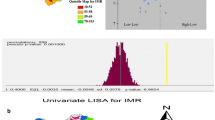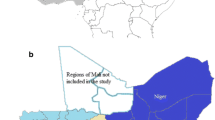Abstract
Infant mortality rate is considered as one of the most important indicators of development of the socio-economic and health status of any country. For Bangladesh, the estimates of infant mortality on 64 districts of the country is available, but these regionally disaggregated estimates, based on sample surveys, may give misleading pictures because in reality they do not capture the neighborhood and contextual influences. If any spatial pattern exists in the characteristics of interest, estimates obtained for a particular district must be adjusted for any spatial effect of the neighboring districts, otherwise the unadjusted estimates alone may give a confounded meaning. Policy implication at regional level on the basis of such estimates may lead to both under coverage and redundancy. In this paper, we utilize a small area estimation approach by intrinsic conditional autoregressive model isolating the effect of the key covariates. Our analysis reveals that there exist spatial autocorrelation in infant mortality over the districts. We obtain revised district level estimates of the infant mortality from available data on infant mortality and other covariates from different sources. We believe our estimates would be more accurate than the nationally available infant mortality dataset. This in the long run, can be supportive in policy measures related to reducing infant mortality.








Similar content being viewed by others
References
Alba, R. D., & Logan, J. R. (1993). Minority proximity to whites in suburbs: An individual-level analysis of segregation. American Journal of Sociology, 98(6), 1388–1427.
Banerjee, S., Gelfand, A. E., & Carlin, B. P. (2004). Hierarchical modeling and analysis for spatial data. London: Chapman and Hall.
Bangladesh Bureau of Statistics (BBS). (2003). Population and housing census: Socio-economic and demographic report national series, Volume-4, 2001. Dhaka: Bangladesh Bureau of Statistics, Statistics Division, Ministry of Planning, Government of the People’s Republic of Bangladesh.
Bangladesh Bureau of Statistics (BBS). (2008). Report on sample vital registration system 2007. Dhaka: Bangladesh Bureau of Statistics.
Bangladesh Bureau of Statistics (BBS). (2009). Report on sample vital registration system 2008. Dhaka: Bangladesh Bureau of Statistics.
Bangladesh Bureau of Statistics (BBS). (2010). Report on sample vital registration system 2009. Dhaka: Bangladesh Bureau of Statistics.
Bangladesh Bureau of Statistics (BBS). (2011). Report on sample vital registration system 2010. Dhaka: Bangladesh Bureau of Statistics.
Bangladesh Bureau of Statistics (BBS). (2013). Report on sample vital registration system 2011. Dhaka: Bangladesh Bureau of Statistics.
Bangladesh Bureau of Statistics (BBS). (2015). Population and housing census: Socio-economic and demographic report national report, Volume-4, 2011. Dhaka: Bangladesh Bureau of Statistics, Statistics and Informatics Division, Ministry of Planning, Government of the People’s Republic of Bangladesh.
Bangladesh Bureau of Statistics (BBS), World Bank, & World Food Programme (WFP). (2010). Updating poverty maps: Bangladesh poverty maps for 2005 technical report. Dhaka: Bangladesh Bureau of Statistics, World Bank, Wold Food Programme.
Bangladesh Bureau of Statistics (BBS), World Bank, & World Food Programme (WFP). (2014). Poverty maps of Bangladesh—2010 technical report. Dhaka: Bangladesh Bureau of Statistics, World Bank, World Food Programme.
Bangladesh Planning Commission. (2014). Millennium development goals: Bangladesh progress report 2013. Dhaka: General Economics Division, Bangladesh Planning Commission, Government of the People’s Republic of Bangladesh.
Beaujeu-Garnier, J. (1966). Geography of population. London: Longman.
Besag, J., York, J., & Mollié, A. (1991). Bayesian image restoration, with two applications in spatial statistics. Annals of the Institute of Statistical Mathematics, 43(1), 1–20.
Black, R. E., Morris, S. S., & Bryce, J. (2003). Where and why are 10 million children dying every year? The Lancet, 361(9376), 2226–2234.
Charles, C. Z. (2003). The dynamics of racial residential segregation. Annual Review of Sociology, 29, 167–207.
Chi, G., & Zhu, J. (2008). Spatial regression models for demographic analysis. Population Research and Policy Review, 27(1), 17–42.
Cressie, N. (1993). Statistics for spatial data. New York: Wiley.
Flegg, A. T. (1982). Inequality of income, illiteracy and medical care as determinants of infant mortality in underdeveloped countries. Population Studies, 36(3), 441–453.
Fong, Y., Rue, H., & Wakefield, J. (2009). Bayesian inference for generalized linear mixed models. Biostatistics, 8(2), 158–183.
Fossett, M. (2005). Urban and spatial demography. In Handbook of population. New York: Springer.
Jones, H. R. (1990). Population geography. New York: The Guilford Press.
Krugman, P. R. (1991). Geography and trade. Cambridge: MIT Press.
Masuy-Stroobant, G., & Gourbin, C. (1995). Infant health and mortality indicators. European Journal of Population, 11(1), 63–84.
National Institute of Population Research and Training (NIPORT), Mitra and Associates, & ICF International. (2013). Bangladesh demographic and health survey 2011. Dhaka, Bangladesh, and Rockville, Maryland, USA: NIPORT, Mitra and Associates, and ICF International.
Rue, H., & Held, L. (2005). Gaussian Markov random fields: Theory and applications. London: Chapman and Hall, CRC Press.
Szwarcwald, C. L., de Andrade, C. L. T., & Bastos, F. I. (2002). Income inequality, residential poverty clustering and infant mortality: A study in Rio de Janeiro Brazil. Social Science and Medicine, 55(12), 2083–2092.
Tiefelsdorf, M. (2000). Modelling spatial processes—The identification and analysis of spatial relationships in regression residuals by means of Moran’s I. Germany: Springer.
Wakefield, J. (2007). Disease mapping and spatial regression with count data. Biostatistics, 8(2), 158–183.
Week, J. R. (2001). The role of spatial analysis in demographic research. New York: Oxford University Press.
Zelinsky, W. (1966). Prologue to population geography. Englewood Cliffs, NJ: Prentice-Hall.
Author information
Authors and Affiliations
Corresponding author
Rights and permissions
About this article
Cite this article
Roy, P.K., Gulshan, J. & Hossain, S.S. Spatially Revised Estimation of Infant Mortality in Bangladesh. Spat Demogr 5, 25–42 (2017). https://doi.org/10.1007/s40980-016-0025-5
Published:
Issue Date:
DOI: https://doi.org/10.1007/s40980-016-0025-5




